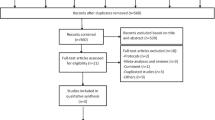Summary
Several compounds have been claimed to have a faster onset of antidepressant action. However, these trials suffered from lack of appropriate definitions and of standardised and comparable methodology, as far as measurement instruments, dosage strategies and statistical analyses were concerned. This article was undertaken to examine the data on the speed of onset of action with the available antidepressant compounds. To date, no compound has clearly been proven to act any faster than others. Electroconvulsive therapy is the modality that seems to produce faster onset of action compared with available medications. The major methodological issues in these studies are reviewed, and areas for future research are suggested.
Similar content being viewed by others
References
Derivan AT. Antidepressants: can we determine how quickly they work? Issues from the literature. Psychopharmacol Bull 1995; 31: 23–8
Gershon S. Antidepressants: can we determine how quickly they work? Psychopharmacol Bull 1995; 31: 21–2
Laska E, Siegel C. Characterizing onset in psychopharmacological clinical trials. Psychopharmacol Bull 1995; 31: 29–35
Leber P. Speed of onset. Psychopharmacol Bull 1995; 31: 37–40
Overall JE. Justifying a ‘fast acting’ claim for antidepressant drugs. Psychopharmacol Bull 1995; 31: 45–55
Frazer A, Scott PA. Onset of action of antidepressant treatments: neuropharmacological aspects. In: Langer SZ, Brunello N, Racagni G, et al., editors. Critical issues in the treatment of affective disorders. Vol. 9. Basel: Karger, 1994: 82–9
Haskell DS, DiMascio A, Prusoff B. Rapidity of symptom reduction in depressions treated with amitriptyline. J Nerv Ment Dis 1975; 160: 24–33
Katz MM, Koslow SH, Maas JW, et al. The timing, specificity and clinical prediction of tricyclic drug effects in depression. Psychol Med 1987; 17: 297–309
Tollefson GD, Holman SL. How long to onset of antidepressant action: a meta-analysis of patients treated with fluoxetine or placebo. Int Clin Psychopharmacol 1994; 9: 245–50
Rickels K, Derivan A, Entsuah R, et al. Rapid onset of antidepressant activity with venlafaxine treatment. Depression 1995; 3: 146–53
George MS, Lydiard RB. Speed of onset of action of the newer antidepressants fluoxetine and bupropion. Int Clin Psychopharmacol 1991; 6: 209–17
Prien RF, Blaine JD, Levin J. Antidepressant drug therapy: the role of the new antidepressants. Hosp Community Psychiatry 1985; 36: 513–6
Katz MM, Koslow SH, Maas JW, et al. Identifying the specific clinical actions of amitriptyline: interrelationships of behaviour, affect and plasma levels in depression. Psychol Med 1991; 21: 599–611
Montgomery SA. Are 2-week trials sufficient to indicate efficacy? Psychopharmacol Bull 1995; 31: 41–4
Laska EM, Siegel C, Sunshine A. Onset and duration: measurement and analysis. Clin Pharmacol Ther 1991; 49: 1–5
Khan A, Cohen S, Dager S, et al. Onset of response in relation to outcome in depressed outpatients with placebo and imipramine. J Affect Dis 1989; 17: 33–8
Quitkin FM, Rabkin JG, Ross D, et al. Identification of true drug response to antidepressants: use of pattern analysis. Arch Gen Psychiatry 1984; 41: 782–6
Quitkin FM, Rabkin JG, Markowitz JM, et al. Use of pattern analysis to identify true drug response: a replication. Arch Gen Psychiatry 1987; 44: 259–64
Quitkin FM, Stewart JW, McGrath PJ, et al. Further evidence that a placebo response to antidepressants can be identified. Am J Psychiatry 1993; 150: 566–70
Angst J, Delini-Stula A, Stabl M, et al. Is a cut-off score a suitable measure of treatment outcome in short-term trials in depression? A methodological meta-analysis. Hum Psychopharmacol 1993; 8: 311–7
Snaith P. What do depression rating scales measure? Br J Psychiatry 1993; 163; 293–8
Hamilton M. A rating scale for depression. J Neurol Neurosurg Psychiatry 1960; 23: 56–62
Montgomery SA, Asberg M. A new depression scale designed to be sensitive to change. Br J Psychiatry 1979; 134: 382–9
Flemenbaum A, Escobar JI, Schiele BC. Clomipramine: a double-blind comparison of intravenous versus oral administration in depressed patients. Psychopharmacologica 1973; 33: 111–6
Pollock BG, Perel JM, Nathan S, et al. Acute antidepressant effect following pulse loading with intravenous and oral clomipramine. Arch Gen Psychiatry 1989; 46: 29–35
Stassen HH, Delini-Stula A, Angst J. Time course of improvement under antidepressant treatment: a survival-analytical approach. Eur Neuropsychopharmacol 1993; 3: 127–35
Rich CL, Spiker DG, Jewell SW, et al. The efficiency of ECT: I. Response rate in depressive episodes. Psychiatry Res 1984; 11: 167–76
Post RM, Uhde TW, Rubinow DR, et al. Differential time course of antidepressant effects after sleep deprivation, ECT, and carbamazepine: clinical and theoretical implications. Psychiatry Res 1987; 22: 11–9
Rodger CR, Scott AIF, Whalley LJ. Is there a delay in the onset of the antidepressant effect of electroconvulsive therapy? Br J Psychiatry 1994; 164: 106–9
Segman RH, Shapira B, Gorfine M, et al. Onset and time course of antidepressant action: psychopharmacological implications of a controlled trial of electroconvulsive therapy. Psychopharmacology 1995; 119: 440–8
Lydiard RB, Pottash AL, Gold MS. Speed of onset of action of the newer antidepressants. Psychopharmacol Bull 1984; 20: 258–71
Bowden CL, Schatzberg AF, Rosenbaum A, et al. Fluoxetine and desipramine in major depressive disorder. J Clin Psychopharmacol 1993; 13: 305–10
Montgomery SA. A new dimension in antidepressant pharmacotherapy. J Clin Psychiatry 1993; 54: 1–8
Derivan A, Entsuah AR, Kikta D. Venlafaxine: measuring the onset of antidepressant action. Psychopharmacol Bull 1995; 31: 439–47
Author information
Authors and Affiliations
Rights and permissions
About this article
Cite this article
Soares, J.C., Gershon, S. Prospects for the Development of New Treatments with a Rapid Onset of Action in Affective Disorders. Drugs 52, 477–482 (1996). https://doi.org/10.2165/00003495-199652040-00001
Published:
Issue Date:
DOI: https://doi.org/10.2165/00003495-199652040-00001




